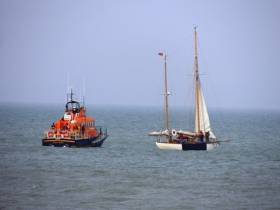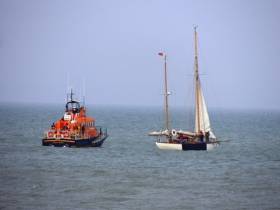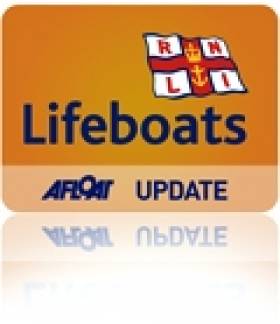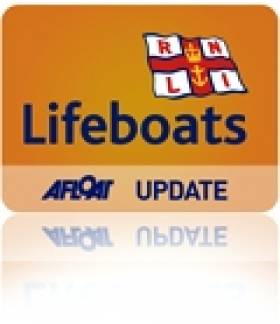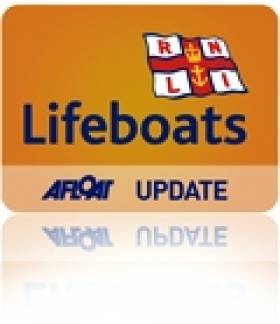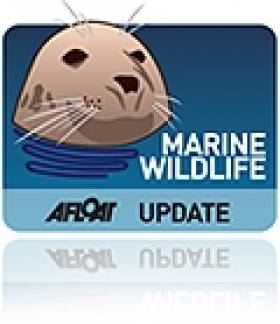Displaying items by tag: Arklow
When the report appeared here on Afloat.ie on Monday about the assistance given by Arklow RNLI to the “stranded” classic yacht off the Arklow pierheads on May 1st, warning bells rang writes W M Nixon.
For classic boat enthusiasts will have instantly recognised that the yacht in question is the 43ft ketch Maybird, built by Tyrrells of Arklow in 1937, and superbly restored in the heart of the classic yacht industry in Southampton between 2009 and 2011 by a team of all the talents in a job project-managed by owner Darryl Hughes.
Most folk on the classic yacht circuit will be aware that Maybird is entered for the Volvo Round Ireland Race from Wicklow on June 18th, in which she’ll be the oldest boat ever to have taken part. And those of us really in the know will have been aware that Darryl Hughes hopes that members of Arklow Sailing Club - and maybe even descendants of the men who built the boat back in 1937 – will be on the crew for the big race.
The Arklow maritime community being what it is, many members of the sailing club are also on the RNLI Lifeboat Crew panel, and thus some of them were on board Maybird when she set off from Cork Harbour to sail for Arklow early last Saturday as part of a programme to build up mileage experience in order to qualify for the round Ireland.
So when the photo appeared on Monday showing Maybird about to be taken in tow on Sunday evening by the Arklow lifeboat after her engine had failed right in the entrance to Arklow Harbour, at first all we could think of was the embarrassment of those on Maybird at having to be “rescued” by their colleagues.
But then we remembered that May 1st, May Day, is a great lifeboat fund-raising day, and particularly so in Arklow. So then cynical thoughts took over, thinking that maybe this was a cleverly-planned fund-raising stunt: Maybird, Mayday, May*rs* we thought.
There are times you can be just too hard-bitten. Turns out the whole story is absolutely kosher. Prior to leaving winter quarters in Crosshaven, when servicing the engine Darryl had noticed the bleed screw on the secondary fuel filter did not seem to be making an airtight fit. But the engine started with no bother, and motored the boat without trouble from Crosshaven to the Custom House Quay in Cork to meet the Arklow crew, and then took Maybird, with full complement aboard, down to Cobh on Friday evening to prepare for departure towards Arklow last Saturday morning.
They’d a fine sail round to the east coast, going outside the Tuskar to simulate round Ireland conditions, but then off the Glassgorman Bank an engine start test failed. There was air in the fuel system, but Darryl solved the problem with plumbers’ PTFE tape on the bleed screw, and they were back in business with a fading breeze, motoring the final miles and stowing sails with the engine performing well.
But just as the pierheads came abeam, the engine cut out. Fortunately Maybird’s multiple-sail rig provides almost instant hoisting of the staysail – “always the last sail to be stowed” – and they were able to sail clear and keep the situation under control while the Arklow lifeboat leapt at the chance to carry out a rescue.
As it happens, Jimmy Mylor, who organises the Arklow Sea Scouts in addition to being on the Lifeboat Crew, had meant to be on Maybird, but work commitments had caused him to drop out. Yet it was he who handed Maybird’s crew the lifeboat’s towing warp amidst much banter, banter which went on for some time.
But now the Arklow marine industry have rallied round to make sure that a new bleed screw on Maybird’s secondary filter is getting a proper seal, and all being well, Maybird will race this Saturday in Arklow SC’s weekend event. We don’t know how much extra RNLI fund-raising was done as a result of this “stunt-for-real”. But the message yet again is that you can only have three problems with a good modern marine diesel engine – fuel, fuel, and fuel.

Maybird as she looks when all is as it should be
Arklow & Bangor Lifeboats Have Busy May Day Weekend
#RNLI - Lifeboats from Arklow and Bangor were out on the water for separate callouts on May Day yesterday in what made for a busy weekend for the RNLI crews.
In Arklow, RNLI lifeboat volunteers were alerted by pager around 7pm on a fine Sunday evening (1 May) to a call for help from a vintage sailing vessel.
The lifeboat Ger Tigchleaar was launched within minutes to the classic boat, which has suffered engine failure and was stranded just east of Arklow Harbour.
The Arklow RNLI volunteer crew established a tow line and proceeded to tow the vessel safely back into Arklow. The five experienced crew members on the casualty vessel remained aboard during the tow home and all hands came ashore safely at Arklow.
Speaking after the incident, volunteer lifeboat press officer and community safety officer Mark Corcoran said: "On this, the RNLI’s Mayday fundraising weekend, our fundraising team and boats crew have been busy with all kinds of fundraising events.
"Even after a long day of fundraising our dedicated volunteers turned up this evening en masse to go to the aid of the crew of this stricken vessel.
"We’re all very proud to be involved with the RNLI, so please give generously to the Mayday campaign to help keep us doing what we do, which is saving lives at sea."
Elsewhere on the same evening, Bangor RNLI’s volunteer lifeboat crew launched to the aid of a RIB with engine failure just off Royal North Yacht Club in Belfast Lough.
Although not in immediate danger, a strong breeze was blowing the vessel, with one person on board, offshore. Thankfully the Bangor inshore lifeboat was able to tow the RIB in to Royal North without incident.
Bangor RNLI volunteer helmsman Gareth Whan said: “The crew and I are delighted to have been able to return this vessel safely to shore. Engine failure can happen in the best-maintained boat, and we are pleased to have been able to help.”
This was Bangor RNLI’s second callout of the weekend. On Friday evening (29 April) they were asked by Belfast Coastguard to assist Lagan Search and Rescue and other emergency services in a detailed search of Belfast Harbour for a person in the water.
Sadly, this callout did not have a happy ending. The search was called off after three hours, and resumed on Saturday morning. However, it was only yesterday (Sunday 1 May) when a body was found by police divers.
Bangor RNLI extended its sympathies to the family of the man and all involved in the attempted rescue.
“It is sadly appropriate that both of these launches happened during the May Day weekend, a key fundraising time for the RNLI, and highlight the importance of the work our volunteers do,” said Bangor's deputy launching authority Bryan Lawther.
#RNLI - Three RNLI lifeboats from Wicklow and Arklow launched after 5am on Tuesday morning (23 February) to assist a grounded fishing vessel with seven people onboard.
The volunteer lifeboat crews quickly located the 20m fishing boat, which had run aground on the Wolf Rock near the beach at Brittas Bay.
Weather conditions in the area at the time were described as blowing north-easterly with Force 4-5 winds and rough seas.
Arriving on scene, the lifeboat crews observed that no one was in immediate danger. No leaks or damage were found during an inspection of the hull.
Towlines were quickly established between the casualty vessel using Wicklow RNLI’s inshore lifeboat. The vessel was re-floated by the all-weather lifeboats from both stations and the vessel was towed clear of the rock and onward to Wicklow Harbour, where she was safely secured alongside the East Pier shortly before 11am.
Speaking following the callout, Wicklow RNLI volunteer lifeboat press officer Tommy Dover said: "Our lifeboat and shore crews had an early call this morning but we were delighted to help and bring this vessel safely to shore.
"The callout was a real team effort this morning where ours crews from both Wicklow and Arklow were able to put their skills and joint training to good use in assisting the fishermen to Wicklow Harbour."
Arklow Lifeboat Assists Sailor And His Dog
#RNLI - Arklow RNLI's volunteers were enjoying their Sunday morning (27 September) when their pagers sounded at 10.55am.
Within minutes Arklow’s all-weather lifeboat Ger Tigchleaar had slipped her moorings and was en route to a catamaran that had reported engine trouble, some eight miles off the coast on the outside of the Arklow Bank.
The lifeboat crew located the casualty, who had re-routed across the bank, and a crew member was put aboard the 9m vessel to assist the sailor.
Once aboard, a towline was quickly established and the lifeboat proceeded the long, slow tow back to Arklow.
The stricken catamaran had been on a passage from Holyhead to Kilmore Quay when it got into difficulty.
All hands – including the sailor's pet dog – came ashore safely on the Avoca River at Arklow.
Arklow RNLI’s volunteer crew on this call out included coxswain Brendan Dillon, mechanic Geoff Kearnes, Roger Tyrell, Aidan Downey, David Lee, Jimmy Myler and Craig O’Reilly.
Speaking following the incident Arklow RNLI volunteer lifeboat press officer Mark Corcoran said: "This man made the call for help early which ensured our crew could get out to his assistance in time.
"No matter how experienced a sailor is, we would always encourage anyone to carry a means for calling for help and plan your passage with sufficient fuel and other required items for the trip."
Arklow Lifeboat Aids Mussel Dredger Taking On Water
#RNLI - Following an alert by pager on Saturday afternoon (5 September), Arklow RNLI’s lifeboat Ger Tigchleaar was launched within minutes to the aid of the casualty vessel that was reported to be taking on water and at risk of sinking.
The volunteer lifeboat crew proceeded to the scene and after locating the fishing vessel 2.4km east of Mizen Head, it was established that the 44-metre mussel dredger was taking on large volumes of water, but was not in immediate risk of sinking as the vessel's own pumps were keeping it afloat.
The skipper of the mussel vessel requested the Arklow lifeboat to standby to assist should the situation worsen and escort the them back to Arklow Harbour.
Upon arrival back at Arklow, where all crew came ashore safely, the vessel was grounded on the slipway to prepare for repairs to be made. At this point the casualty vessel's pumps failed.
Immediately the Arklow lifeboats crew rendered assistance and put crew and a salvage pump aboard to help empty the hull of water. They assisted in stemming the ingress of water and making a temporary repair using one of the lifeboat crew's trademark yellow wellies as part of the temporary fix.
Speaking following the incident, Arklow RNLI volunteer lifeboat press officer Mark Corcoran said: “Thankfully the skipper of this vessel made the call for help early. When you are going to sea in any vessel always plan for the worst, always carry a means of calling for help and never hesitate in making the call to 999 or 112 or contacting the coastguard via marine VHF.:
Arklow RNLI’s volunteer lifeboat crew for this callout were Brendan Dillon, Michael Fitzgerald, Geoff Kearnes, Jimmy Myler, Eddie McElheron, Leigh Downey and Craig O’Reilly.
Arklow, Howth Lifeboats Aid Stricken Sailing Vessels
#RNLI - Following a lifeboat pager alert at 1.18pm yesterday afternoon (Thursday 9 July), Arklow RNLI's volunteer crew launched to a stricken sailing vessel.
Within minutes of the alert, the lifeboat Ger Tigchleaar was en route from Arklow Harbour in good weather and slack winds to the casualty boat, a local sailing yacht about 1.5 miles north. The vessel, with two crew onboard, had suffered engine failure.
Under the direction of coxswain Ned Dillon, the lifeboat crew – Michael Fitzgerald, Andrew Loughlin, Jimmy Myler and Leigh Downey – secured a tow line to the vessel and brought her and her crew back safely to Arklow Harbour, bringing her alongside at the inner dock marina pontoons.
Speaking following the callout, Arklow RNLI volunteer press officer Mark Corcoran said: "Even very experienced sailors can get into difficulty. If you’re going out on the sea, be prepared and plan for the worst and always have a means of calling for help. Always respect the water."
Howth RNLI had a trickier callout to deal with three days earlier after a sailing yacht beached on rocks at Lambay Island.
The lifeboat was on scene and located the casualty vessel just before 11.00am on Monday 6 July. Volunteer lifeboat crew Ian Martin and Ian Sheridan launched their small XP inflatable boat and went ashore to investigate in poor weather conditions, with the win gusting to 58 knots and a rough sea state.
Two men were located aboard and the decision was made by lifeboat coxswain Fred Connolly to request the coastguard helicopter to lift the casualties to safety as the sea was too rough to risk a transfer to the all-weather lifeboat using the XP inflatable.
The two men were airlifted to safety and the lifeboat returned to station in what was described by the volunteer crew as "challenging conditions".
#RNLI - Arklow RNLI’s volunteer lifeboat crew were alerted by pager at 6.44pm yesterday evening (14 June) to a call for help from a local fishing vessel in the station's second callout of the week, following the lifeboat's midweek rescue of a stricken sailboat.
The crew consisting of coxswain Ned Dillon, station mechanic Michael Fitzgerald, John Bermingham, Scotty Heaney, Keith Forde and Eddie McElheron launched the lifeboat Ger Tigchleaar and proceeded to the vessel, which had suffered machinery failure and was adrift outside the mouth of Arklow Harbour.
After locating the casualty vessel, the lifeboat crew established a tow line and proceeded back in to Arklow with the vessel alongside. All crew members aboard the casualty remained aboard during the service and all hands came ashore safely.
Speaking following the incident, Arklow RNLI volunteer lifeboat press officer Mark Corcoran said: "All people who take to the water whether for a living or for pleasure must always wear their lifejackets and should always have a means of raising the alarm."
Elsewhere, RNLI volunteers aboard Donaghadee's all-weather lifeboat Saxon sped to the rescue of a stricken vessel as darkness fell on Friday evening (12 June).
The 10-metre craft with a crew of one developed engine trouble on a passage to Westport in Co Mayo and was adrift in the busy sea lanes at the mouth of Belfast Lough.
The Donaghadee lifeboat launched at the request of the coastguard at 10.15pm and conducted a search in the gathering gloom one mile north of the Copeland Islands until the vessel was located.
In light sea conditions, a member of the RNLI crew boarded the vessel to assist with repairs and the lifeboat then escorted it to the safety of Bangor Marina. Saxon was back on station and stood down shortly after midnight.
Donaghadee RNLI coxswain Philip McNamara advised all boat owners "to conduct a thorough check of their engines, communications and safety equipment before putting to sea.
"If you encounter a problem, call for assistance at the earliest opportunity. We are ready to be of service and It is always better to be safe than sorry."
Arklow Lifeboat In Midweek Callout To Sailboat In Difficulty
#RNLI - Arklow RNLI came to the assistance of a sailing vessel with sail damage and mechanical failure on Wednesday evening (10 June).
Following a planned exercise, Arklow lifeboat Ger Tigchlearr and its volunteer crew of Eamonn Kavanagh, John Berminghham, Michael Fitzgerald, Jimmy Myler and Trevor Conroy were returning to station around 8.30pm when a distress call was received from the vessel, about one mile south-east of Arklow Harbour.
The lifeboat crew proceeded to the location and took the vessel under tow back to Arklow, where all hands came ashore safely.
Following the rescue, Arklow RNLI sea safety officer Mark Corcoran said: "All skippers of vessels going to sea for work or pleasure should carry a means of calling for help and wear lifejackets.
"Calling for help in good time will lessen the chances of people ending up in the water and increase the chances of successful rescue."
Jimmy Tyrrell – An Arklow Maritime Legend
#arklow legend – We are fortunate in this country to have people who are dedicated to the marine sphere and who give freely and willingly of their time and efforts in pursuit of their belief that maritime matters really should matter to the national community.
Jimmy Tyrell from Arklow is such a man. I have known and respected him through his work for the lifeboats for many years.
The RNLI has a proud history of over 190 years and the port of Arklow in County Wicklow, a town founded by the Vikings in the 9th century, lays claim to being the first lifeboat station established in Ireland, back in 1826. Jimmy Tyrrell has led lifeboat operations there for 46 years. His family is legendary in maritime matters.
Twenty-seven years ago Jimmy made a decision. The RNLI named its different classes of boat designs after rivers, but had never used the name of an Irish river. Jimmy was determined to change that and being a determined man, he achieved his goal. So when the new Shannon Class was born, the most modern vessel in the RNLI fleet and the first into Ireland arrived at the Lough Swilly Station at Buncrana in County Donegal, Jimmy was there to see it.
It was a great day for Jimmy, well-deserved and he describes his feeling as he saw the boat arrive on this edition of THIS ISLAND NATION.
When Jimmy retired from RNLI duties in Arklow another member of that great maritime family stood up to take over from him and continue the family association, John Tyrrell, who is now Lifeboat Operations Manager there.
The new Shannon lifeboat at Lough Swilly cost €2.4m and was designed by a Derry man who works for the RNLI at its Poole headquarters. It uses twin waterjets instead of propellers, giving it more manoeuvrability and the ability to operate in shallow waters. The man who designed it is Peter Eyre and he was once saved by the lifeboat service when he got into difficulty on the water, the story of which he tells also on the current edition of THIS ISLAND NATION.
When the RNLI describes a boat as "all-weather..." they mean it, the service always responds to calls for help, even in the worst of sea conditions, so the crews deserve the best boats. The Shannon has a top speed of 25 knots, a range of 250 nautical miles and a unique hull to minimise slamming of the boat in heavy seas, with shock-absorbing seats to protect the crew from impact when powering through the waves. The Lough Swilly lifeboat has been largely funded through a legacy from Derek Jim Bullivant of Bewdley, Worcestershire, in the UK who died in September of 2011.and is named Derek Bullivant. Coxswain, Mark Bennett, commands it and was welcomed by a huge crowd when he and his crew brought the boat from Poole to Buncrana. He tells us how it was an emotional day for him.
BASS BAN
This edition of Ireland's niche maritime programme also has an interesting story about supermarket advertising which can mislead purchasers into thinking they are buying Irish bass when it is illegal to catch them for commercial purposes in Irish waters, where such fishing is banned. So why are the public misled by advertising which says "Irish produced bass" when they come from fish farms abroad?
David Stanton, the Fine Gael TD for Cork East interested – and somewhat pleasantly surprised me – by making an issue of the lack of Government and State attention to the marine sphere. It's not often, I put to him, that a politician is heard to draw attention to maritime matters. He has a good point -that there is no single, central point in the State system, no 'one-stop-shop,' where all maritime enquiries can be dealt with, so anyone proposing a project can be sent from one section of the State services to another so many times they could meet themselves coming back. He is worth listening to and I'll be looking forward to hearing how the self-imposed mission he has declared, to highlight maritime affairs at Government level, gets on.
The island communities join the programme with a regular report, in which we hear why €60,000 a year, not a huge sum of money, is vital to education on the islands.
A lot then, about maritime matters which you can hear THIS ISLAND NATION by clicking on the programme icon above
Your comments are welcome below.
Akrlow Seal 'Sammy' Rescued Near Rocky Shoreline
#MarineWildlife - On Friday morning (3 April) Arklow RNLI was made aware of a seal apparently caught in fishing gear close to the Arklow Harbour entrance.
Two of Arklow RNLI’s team went to the area to ascertain if it was feasible to launch the lifeboat to rescue the weary marine mammal, identified locally as Sammy - the subject of a previous rescue some 18 months ago when still a pup.
Due to conditions in the area and due to the proximity of the shoreline and an ebbing tide at the location, it was decided it was inadvisable to launch the Ger Tigchelaar.
Because of the trapped animal's proximity to the shore, and to eliminate the further risk of any members of the public entering the water to save the seal, it was decided instead to try to rescue the animal from a smaller rescue craft.
Two of Arklow RNLI’s volunteers, station mechanic Michael Fitzgerald, and Brian Heaney, went to sea to the aid of the tiring animal.
After hauling in the fishing gear, the exhausted and stressed seal was moved to an area where it could make for the shore to rest and was then cut loose from the fishing gear.
The seal had a short break on the lower rocks of the shoreline before making for open water.
Speaking following the incident, Fitzgerald said: “Luckily we were able to get to the seal in time to save it.
"When members of the pubic come across injured or stressed animals like this trapped in fishing gear or injured, they should inform the authorities immediately, they should never enter the water to try to save the animal.
"They should always leave this to persons who are experienced and have the right equipment to carry out the rescue safely. Always respect the water.”


























